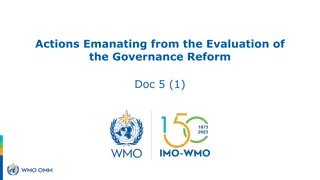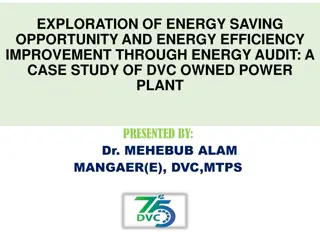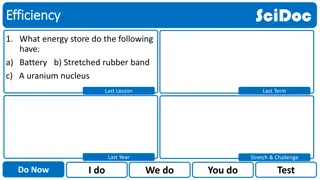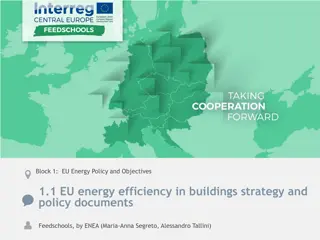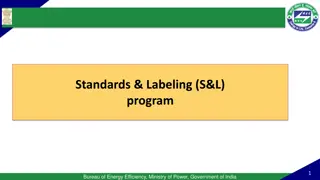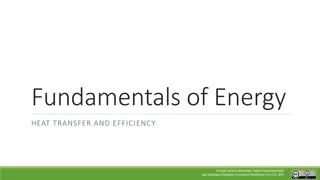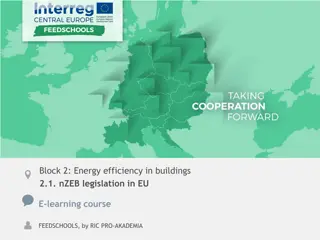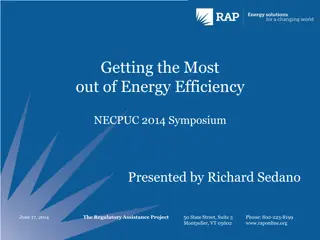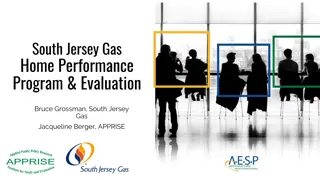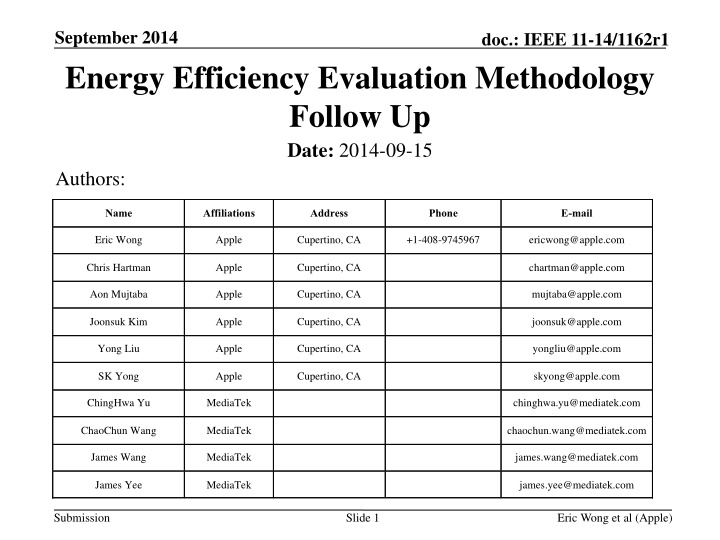
Energy Efficiency Evaluation Methodology in September 2014
Detailed energy efficiency evaluation methodology for September 2014 presented by authors from Apple and Nokia, focusing on the evaluation of energy efficiency metrics, power save mechanisms, and the Energy Efficiency Ratio for the 802.11ax protocol.
Download Presentation

Please find below an Image/Link to download the presentation.
The content on the website is provided AS IS for your information and personal use only. It may not be sold, licensed, or shared on other websites without obtaining consent from the author. If you encounter any issues during the download, it is possible that the publisher has removed the file from their server.
You are allowed to download the files provided on this website for personal or commercial use, subject to the condition that they are used lawfully. All files are the property of their respective owners.
The content on the website is provided AS IS for your information and personal use only. It may not be sold, licensed, or shared on other websites without obtaining consent from the author.
E N D
Presentation Transcript
September 2014 Energy Efficiency Evaluation Methodology Follow Up Date: 2014-09-15 Authors: doc.: IEEE 11-14/1162r1 Name Affiliations Address Phone E-mail Eric Wong Apple Cupertino, CA +1-408-9745967 ericwong@apple.com Chris Hartman Apple Cupertino, CA chartman@apple.com Aon Mujtaba Apple Cupertino, CA mujtaba@apple.com Joonsuk Kim Apple Cupertino, CA joonsuk@apple.com Yong Liu Apple Cupertino, CA yongliu@apple.com SK Yong Apple Cupertino, CA skyong@apple.com ChingHwa Yu MediaTek chinghwa.yu@mediatek.com ChaoChun Wang MediaTek chaochun.wang@mediatek.com James Wang MediaTek james.wang@mediatek.com James Yee MediaTek james.yee@mediatek.com Submission Slide 1 Eric Wong et al (Apple)
September 2014 doc.: IEEE 11-14/1162r1 Authors: Name Affiliations Address Phone E-mail Chittabrata Ghosh Nokia chittabrata.ghosh@nokia.com Sayantan Choudhury Nokia sayantan.choudhury@nokia.com Jarkko Kneckt Nokia jarkko.kneckt@nokia.com Esa Tuomaala Nokia esa.tuomaala@nokia.com Submission Slide 2 Eric Wong et al (Apple)
September 2014 doc.: IEEE 11-14/1162r1 Outline Energy efficiency evaluation recap Feedback and discussions Conclusion Submission Slide 3 Eric Wong et al (Apple)
September 2014 doc.: IEEE 11-14/1162r1 Energy Efficiency Evaluation Recap The previous contribution (11-14/827r3) proposes a systems approach (covering both PHY and MAC) to evaluate energy efficiency for 802.11ax; this is similar to how throughput performance is evaluated for previous 802.11 amendments Change the simulation scenario [2] and evaluation methodology [3] documents as follows: Add definitions for energy efficiency metrics in Slide 4 of [1] Add power tables in Slides 18-19 of [1] Propose to select one or more of the 3 power save mechanisms as the reference point, i.e. Power save mode (PSM) Power save polling (PSP) Unscheduled automatic power save delivery (U-APSD) Add power save mechanism to each simulation scenario (and associated traffic models) Incorporate proposed power model to the evaluation methodology document Add definition for Energy Efficiency Ratio Submission Slide 4 Eric Wong et al (Apple)
September 2014 doc.: IEEE 11-14/1162r1 Energy Efficiency Ratio According to the PAR, the 802.11ax protocol should meet the following 3 requirements 4 times average Per-STA throughput improvement [1] Transmission latency constraints requirements (TBD; see [3]) Maintain or reduce energy per successful information bit, i.e. energy efficiency ratio of at least one or less To verify the 3rd requirement, we propose to use Energy Efficiency Ratio Energy Efficiency Ratio is defined as the ratio of average energy consumed for one bit of data successfully exchanged between STAs using any new proposed power save mechanism over the baseline power save mechanism, i.e. EER=New "Average Energy Per Bit" Old "Average Energy Per Bit" Average energy per bit is calculated based on the same time interval used for computing average throughput Proposed power save mechanisms should have an EER 1 Submission Slide 5 Eric Wong et al (Apple)
September 2014 doc.: IEEE 11-14/1162r1 Feedback and Discussions Must the 802.11ax specification support a mode of operation that is subjected to power save requirement? Yes, there has to be at least one mode that clearly demonstrate power save of EER 1 Not every proposal is subjected to this Is power save calibration across different system simulators required? For simulators that implement one or more of the existing power save mechanisms, a basic power save calibration is recommended Suggested power save calibration scenarios are going to be defined in [4] How are the different power save mechanisms mapped into scenarios and traffic models? (Slide 11 of [1]) We suggest to use one or more of the three baseline power save mechanisms (i.e. PSM, PSP and U-APSD) for all simulation scenarios We are suggesting a baseline power save mechanism for each traffic model Submission Slide 6 Eric Wong et al (Apple)
September 2014 doc.: IEEE 11-14/1162r1 Conclusion This a follow up contribution to energy efficiency evaluation methodology 11-14/827r3 that provides An update on the Energy Efficiency Ratio Discussed feedback received from 11-14/827r3 Submission Slide 7 Eric Wong et al (Apple)
September 2014 doc.: IEEE 11-14/1162r1 Straw Poll 1.1 Do you agree, in principle, to add metrics corresponding to energy efficiency to the evaluation methodology document (11-14/571r3)? Yes No Abstain Submission Slide 8 Eric Wong et al (Apple)
September 2014 doc.: IEEE 11-14/1162r1 Straw Poll 1.2 Do you support adding the following definition for Energy Efficiency Ratio (EER) to the evaluation methodology document (11-14/571r3)? Energy efficiency ratio is defined as the ratio of average energy consumed for one bit of data successfully exchanged between STAs using any new proposed power save mechanism over the baseline power save mechanism EER=New "Average Energy Per Bit" Old "Average Energy Per Bit" Yes No Abstain Submission Slide 9 Eric Wong et al (Apple)
September 2014 doc.: IEEE 11-14/1162r1 Straw Poll 1.3 Do you support adding these metrics to the evaluation methodology document (11- 14/571r3)? Metric Units Definition Total energy consumed by a STA divided by the total number of successful data bits transmitted by the STA Per-STA energy per TX bit Joules/bit Total energy consumed by a STA divided by the total number of successful data bits received by the STA Per-STA energy per RX bit Joules/bit Yes No Abstain Submission Slide 10 Eric Wong et al (Apple)
September 2014 doc.: IEEE 11-14/1162r1 Straw Poll 2.1 Do you support adding standardized power tables for purposes of computing energy consumption to the simulation scenario document (11-14/980r2)? Yes No Abstain Submission Slide 11 Eric Wong et al (Apple)
September 2014 doc.: IEEE 11-14/1162r1 Straw Poll 2.2 Do you support adding the following power table (whose entries are TBD) to the simulation scenario document (11-14/980r2)? Average Power Consumption (mW) Bandwidth = { 20 MHz }, Band = { 2.4 GHz, 5 GHz }, NSS = { 1 }, Number of TX/RX antennas = { 1 }, TX power per antenna = { 15 dBm } Power State Transmit Receive Listen Sleep Yes No Abstain Submission Slide 12 Eric Wong et al (Apple)
September 2014 doc.: IEEE 11-14/1162r1 Straw Poll 2.3 Do you support adding the following power transition table (whose entries are TBD) to the simulation scenario document (11-14/980r2)? State Transitions Transition Time (ms) Average Power Consumption (mW) Transmit Listen 0 0 Receive Listen 0 0 TRT (e.g. SIFS of 16us) PRT Receive Transmit TTS PTS Transmit Sleep TRS PRS Receive Sleep Listen Sleep TLS PLS Yes No Abstain Submission Slide 13 Eric Wong et al (Apple)
September 2014 doc.: IEEE 11-14/1162r1 Straw Poll 3.1 Do you support to include a column in Reference Traffic Profile, in Annex 1 to the simulation scenario document (11-14/980r2), to indicate a baseline power save mechanism for each traffic model? Yes No Abstain Submission Slide 14 Eric Wong et al (Apple)
September 2014 doc.: IEEE 11-14/1162r1 Straw Poll 3.2 The baseline power save mechanism is one of the following power save mechanisms defined in [4]? a. Power save mode (PSM) b. Power save polling (PSP) c. Unscheduled automatic power save delivery (U-APSD) d. Not applicable Yes No Abstain Submission Slide 15 Eric Wong et al (Apple)
September 2014 doc.: IEEE 11-14/1162r1 References 1. 2. 3. 4. E. Wong et al, Energy Efficiency Evaluation Methodology, IEEE 11-14-827r3 S. Merlin et al, TGax Simulation Scenarios, IEEE 11-14-980r2 R. Porat et al, 11ax Evaluation Methodology, IEEE 11-14-571r2 E. Wong et al, Parameters on Power Save Mechanisms, IEEE 11-14-1161r0 Submission Slide 16 Eric Wong et al (Apple)


